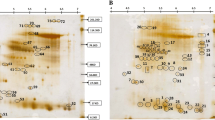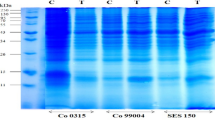Abstract
The interactive effect of temperature with other climatic and soil factors has profound influences on the growth and development of rice. The responses of rice to high temperatures under field conditions are more important than those under the controlled conditions. To understand the genes associated with high temperature stress response in general and tolerance in particular, the expression of all those genes associated with adaptation and tolerance in rice requires proteomic analysis. High temperature stress-tolerant cv. N22 was subjected to 28/18 °C (control) and 42/32 °C (high temperature stress) at flowering stage. The plants were grown in the field under the free air temperature increment condition. The proteomic changes in rice leaves due to high temperature stress were discussed. The proteomes of leaves had about 3000 protein spots, reproducibly detected on 2-dimensional electrophoretic gels with 573 proteins differentially expressed between the control and the high temperature treatments. Putative physiological functions suggested five categories such as growth (15.4 %), heat shock proteins (7.7 %), regulatory proteins (26.9 %), redox homeostasis proteins (11.5 %) and energy and metabolism (38.5 %) related proteins. The results of the present study suggest that cv. N22, an agronomically recognized temperature tolerant rice cultivar copes with high temperature stress in a complex manner. Several functional proteins play important roles in its responses. The predicted climate change events necessitate more studies using this cultivar under different simulated ecological conditions to identify proteomic changes and the associated genes to be used as biomarkers and to gain a better understanding on the biochemical pathways involved in tolerance.






Similar content being viewed by others
References
Lin SK, Chang MC, Tsai YG, Lur HS (2005) Proteomic analysis of the expression of proteins related to rice quality during caryopsis development and the effect of high temperature on expression. Proteomics 5:2140–2156
Ferreira S, Hjerno K, Larsen M, Wingsle G, Larsen P, Fey S, Roepstorff P, Salomé Pais M (2006) Proteome profiling of Populus euphratica Oliv. upon heat stress. Ann Bot 98:361–377
Jagadish SVK, Muthurajan R, Oane R, Wheeler TR, Heuer S, Bennett J, Craufurd PQ (2010) Physiological and proteomic approaches to address heat tolerance during anthesis in rice (Oryza sativa L.). J Expl Bot 61(1):143–156
Das S, Krishnan P, Monalisa N, Ramakrishnan B (2014) High temperature stress effects on pollens of rice (Oryza sativa L.) genotypes. Environ Exp Bot 101:36–46
IPCC (2012) Managing the risks of extreme events and disasters to advance climate change adaptation. In: Barros V, Stocker TF, Qin D, Dokken DJ, Ebi KL, Mastrandrea MD, Mach KJ, Plattner GK, Allen SK, Tignor M, Midgley PM, Field CB (eds) A special report of working groups I and II of the intergovernmental panel on climate change. Cambridge University Press, Cambridge
Peng S, Huang J, Sheehy JE, Laza RC, Visperas RM, Zhong X, Centeno GS, Khush GS, Cassman KG (2004) Rice yields decline with higher night temperature from global warming. Proc Natl Acad Sci USA 01:9971–9975
Weerakoon WMW, Maruyama A, Ohba K (2008) Impact of humidity on temperature-induced grain sterility in rice (Oryza sativa L.). J Agron Crop Sci 194:135–140
Wassmann R, Jagadish SVK, Sumfleth K, Pathak H, Howell G, Ismail A, Serraj R, Redoña E, Singh RK, Heuer S (2009) Regional vulnerability of climate change: impacts on Asian rice production and scope for adaptation. Adv Agron 102:91–133
Mohammed AR, Tarpley L (2009) Impact of high night time temperature on respiration, membrane stability, antioxidant capacity, and yield of rice plants. Crop Sci 49:313–322
Ishimaru T, Hirabayashi H, Ida M, Takai T, San-Oh YA, Yoshinaga S, Ando I, Ogawa T, Kondo M (2010) A genetic resource for early-morning flowering trait of wild rice Oryza officinalis to mitigate high temperature-induced spikelet sterility at anthesis. Ann Bot 106(3):515–520
Zhang G, Chen L, Zhang S, Zheng H, Liu G (2009) Effects of high temperature stress on microscopic and ultrastructural characteristics of mesophyll cells in flag leaves of rice. Rice Sci 16:65–71
Kim HJ, Song EJ, Lee KJ (2002) Proteomic analysis of protein phosphorylations in heat shock response and thermotolerance. J Biol Chem 277:23193–23207
IRGSP (International Rice Genome Sequencing Project) (2005) The map-based sequence of the rice genome. Nature 436:793–800
Umeda M, Hara C, Matsubayashi Y, Li HH, Liu Q, Tadokoro F, Aotsuka S, Uchimiya H (1994) Expressed sequence tags from cultured cells of rice (Oryza sativa L.) under stressed conditions: analysis of transcripts of genes engaged in ATP-generating pathways. Plant Mol Biol 25:469–478
Gorantla M, Babu PR, Lachagari Reddy VB, Reddy AMM, Ramakrishna W, Jeffrey LB, Reddy Arjula R (2007) Identification of stress-responsive genes in an indica rice (Oryza sativa L) using ESTs generated from drought-stressed seedlings. J Exp Bot 58(2):253–265
Lenka SK, Katiyar A, Chinnusamy V, Bansal KC (2011) Comparative analysis of drought-responsive transcriptome in Indica rice genotypes with contrasting drought tolerance. Plant Biotechnol J 9:315–327
Pandey A, Mann M (2000) Proteomics to study genes and genomes. Nature 405:837–846
Komatsu S (2005) Review—rice proteomics: a step toward functional analysis of stress responses. Curr Proteomics 2:325–333
Cushman JC, Bohnert H (2000) Genomic approaches to plant stress tolerance. Curr Opin Plant Biol 3:117–124
Agrawal GK, Rakwal R (2011) Rice proteomics: a move toward expanded proteome coverage to comparative and functional proteomics uncovers the mysteries of rice and plant biology. Proteomics 11(9):1630–1649
Majoul T, Bancel E, Triboï E, Ben Hamida J, Branlard G (2003) Proteomic analysis of the effect of heat stress on hexaploid wheat grain: characterization of heat-responsive proteins from total endosperm. Proteomics 3:175–183
Süle A, Vanrobaeys F, Hajó G, Van Beeumen J, Devreese B (2004) Proteomic analysis of small heat shock protein isoforms in barley shoots. Phytochemistry 65:1853–1863
Chen HH, Shen ZY, Li PH (1982) Adaptability of crop plants to high temperature stress. Crop Sci 22:719–725
Yoshida S (1981) Physiological analysis of rice yield. In: Yoshida S (ed) Fundamentals of rice crop science. International Rice Research Institute, Los Banos, pp 231–251
Jagadish SVK, Craufurd PQ, Wheeler TR (2008) Phenotyping parents of mapping populations of rice for heat tolerance during anthesis. Crop Sci 48:1140–1146
Krishnan P, Ramakrishnan B, Das Smruti, Kumar Ritesh, Verma APS (2013) FATI technology to assess high temperature impact on rice crop. ICAR Newslett 19(2):2–3
Cho K, Tores NL, Subramanyam S, Deepak SA, Sardesai N, Han O, Williams CE, Ishii H, Kubo A, Iwahashi H (2006) Protein extraction/solubilization protocol for monocot and dicot plant gel-based proteomics. J Plant Biol 49(6):413–420
Bradford MM (1976) Rapid and sensitive method for the quantitation of microgram quantities of protein utilizing the principle of protein-dye binding. Anal Biochem 72:248–254
Imin N, Kerim T, Weinman JJ, Rolfe BG (2006) Low temperature treatment at the young microspore stage induces protein changes in rice anthers. Mol Cell Proteomics 5:274–292
Chen J, Shi J, Tian D, Yang L, Luo Y, Yin D, Hu X (2011) Improved protein identification using a species-specific protein/peptide database derived from expressed sequence tags. Plant Omics J 4(5):257–263
Gupta OP, Mishra V, Singh NK, Tiwari R, Sharma P, Gupta RK, Sharma Indu (2015) Deciphering the dynamics of changing proteins of tolerant and intolerant wheat seedlings subjected to heat stress. Mol Biol Rep 42(1):43–51. doi:10.1007/s11033-014-3738-9
Sun Z, Biela LM, Hamilton KL, Reardon KF (2012) Concentration-dependent effects of the soy phytoestrogen genistein on the proteome of cultured Cardiomyocytes. J Proteomics 75:3592–3604
Wasinger VC, Zeng M, Yau Y (2013) Current status and advances in quantitative proteomic mass spectrometry. Int J Proteomics 180605
Lin CJ, Li CY, Lin SK, Yang FH, Huang JJ, Liu YH, Lur HS (2010) Influence of high temperature during grain filling on the accumulation of storage proteins and grain quality in rice (Oryza sativa L.). J Agric Food Chem 58:10545–10552
Zhang X, Takano T, Liu S (2006) Identification of a mitochondrial ATP synthase small subunit gene (RMtATP6) expressed in response to salts and osmotic stresses in rice (Oryza sativa L.). J Exp Bot 57:193–200
Zou J, Liu C, Chen X (2011) Proteomics of rice in response to heat stress and advances in genetic engineering for heat tolerance in rice. Plant Cell Rep 30:2155–2165
Lee DG, Ahsa N, Lee SH, Kang KY, Bahk JD, Lee IJ, Lee BH (2007) A proteomic approach in analyzing heat responsive proteins in rice leaves. Proteomics 7:3369–3383
Mittal D, Enoki Y, Lavania D, Singh A, Sakurai H, Grover A (2011) Binding affinities and interactions among different heat shock element types and heat shock factors in rice (Oryza sativa L.). FEBS J 278:3076–3085
Zhu Y, Zhu G, Guo Q, Zhu Z, Wang C, Liu Z (2013) A comparative proteomic analysis of Pinellia ternata leaves exposed to heat stress. Int J Mol Sci 14:20614–20634
Das S, Krishnan P, Monalisa N, Ramakrishnan B (2013) Changes in antioxidant isozymes as a biomarker for characterizing high temperature stress tolerance in rice (Oryza sativa L) spikelets. Exp Agric (UK) 49(1):53–73
Krishnan P, Ramakrishnan B, Raja Reddy K, Reddy VR (2011) High temperature stress effects on rice plant growth and yield. Adv Agron 111:87–206
Chen X, Zhang W, Zhang B, Zhou J, Wang Y, Yang Q, Ke Y, He H (2011) Phosphoproteins regulated by heat stress in rice leaves. Proteome Sci 9:37
Mizuno K, Iida T, Takano A, Yokoyama M, Fujimura T (2003) A new 9-lipoxygenase cDNA from developing rice seeds. Plant Cell Physiol 44:1168–1175
Osugi A, Itoh Hironori, Ikeda-Kawakatsu Kyoko, Takano Makoto, Izawa Takeshi (2011) Molecular dissection of the roles of phytochrome in photoperiodic flowering in rice. Plant Physiol 157(3):1128–1137
Pujol C, Bailly M, Kern D, Maréchal-Drouard L, Becker H, Duchêne AM (2008) Dual-targeted tRNA-dependent amidotransferase ensures both mitochondrial and chloroplastic Gln-tRNAGln synthesis in plants. Proc Natl Acad Sci USA 105(17):6481–6485
Hirano K, Hino Shingo, Oshima Kenzi, Okajima Tetsuya, Nadano Daita, Urisu Atsuo, Takaiwa Fumio, Matsuda Tsukasa (2013) Allergenic potential of rice pollen proteins: expression, immuno-cross reactivity and IgE-binding. J Biochem 154(2):195–205
Hartmann J, Stührwohldt N, Dahlke RI, Sauter M (2013) Phytosulfokine control of growth occurs in the epidermis, is likely to be non-cell autonomous and is dependent on brassinosteroids. Plant J 73:579–590
Rocco M, Arena S, Renzone G, Scippa GS, Lomaglio T, Verrillo F, Scaloni A, Marra M (2013) Proteomic analysis of temperature stress-responsive proteins in Arabidopsis thaliana rosette leaves. Mol BioSyst 9:1257–1267
Janniere L, Canceill D, Suski C, Kanga S, Dalmais B, Lestini R, Monnier AF, Chapuis J, Bolotin A, Marina T, Le Chatelier E, Ehrlich SD (2007) Genetic evidence for a link between glycolysis and DNA replication. PLoS ONE 2(5):e447
Rollins JA, Habte E, Templer SE, Colby T, Schmidt J, von Korff M (2013) Leaf proteome alterations in the context of physiological and morphological responses to drought and heat stress in barley (Hordeum vulgare L.). J Exp Bot 64(11):3201–3212
Acknowledgments
This research was supported by grants from the Science and Engineering Research Council (SERC), Department of Science and Technology (DST), Government of India, for the project on “High temperature stress response and associated changes in growth and yield of rice (Oryza sativa L),” to P. K. and B. R. We acknowledge the facilities and support provided by the Director, ICAR-IARI, New Delhi and Project Director, ICAR-NRCPB, New Delhi. S. Das is grateful to DST for the support of Junior Research Fellowship. None of the co-authors have a conflict of interest in submitting this manuscript.
Author information
Authors and Affiliations
Corresponding author
Ethics declarations
Conflict of Interest
The authors declare that they have no competing interests.
Electronic supplementary material
Below is the link to the electronic supplementary material.
Rights and permissions
About this article
Cite this article
Das, S., Krishnan, P., Mishra, V. et al. Proteomic changes in rice leaves grown under open field high temperature stress conditions. Mol Biol Rep 42, 1545–1558 (2015). https://doi.org/10.1007/s11033-015-3923-5
Received:
Accepted:
Published:
Issue Date:
DOI: https://doi.org/10.1007/s11033-015-3923-5




